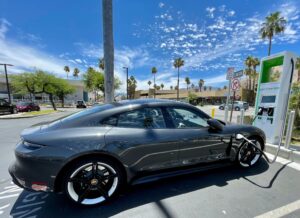Overview:
After taking a glance at how the US and Europe markets are gaining traction in the EV industry, we now proceed towards Asia. In recent times, the EV industry around the Asian regions has experienced huge developments. The Asia-Pacific electric car market is predicted to grow during 2021-2028 at a CAGR of 34.6 % by value and would reach $761.9 billion by 2028. The market would be driven by factors such as cooperative government schemes and regulations, hike in investments by leading automotive OEMs, and diminishing battery prices. Furthermore, the increase in endorsement of electric mobility in emerging APAC countries and increasing EV and battery manufacturing potential in Southeast Asia will lay out remarkable opportunities in this market. Yet, insufficient charging infrastructure in countries such as India, Malaysia, and Indonesia could block the growth of this market marginally. The high cost of electric vehicles and range limitation of EVs are few major challenges for the Asia-Pacific electric cars market.
Growth-and-adoption-of-EV-sales-across-Asia-Part-3Top players in the Asia EV market:
BYD: Ranked no. 1 in global sales for six consecutive years from 2014 to 2019, the biggest Chinese electric car brand BYD is the fourth largest electric vehicle manufacturer in the world today with a market share of nearly 6.5% reported in 2021. According to local Chinese reports, its monthly sales are already approaching 1 lakh units, the most popular model being e6. It expects to sell around 6 lakh battery electric vehicles (BEVs) and between 5 to 6 lakh plug-in hybrid EVs (PHEVs) during 2022.
Hyundai: Korean auto giant Hyundai Motor is the fifth largest EV maker in the world as far as sales numbers went in 2021. Starting off with Kona electric SUV, Hyundai has now drawn out its IONIQ family of electric cars. Hyundai is reported to hold nearly 5% of market share. Hyundai has also developed wireless electric vehicle charging system, in partnership with Kia.
The three major Asian countries/markets:
China, Japan and South Korea together lead in the field of electro mobility worldwide. While South Korea is strong in technology, Japan and China have a strong stand in terms of manufacturing and market size. According to Electric Vehicle Index 2021:
| Countries | Technology Index Score | Industry Index Score | Market Index Score |
| China | 2.9 | 5 | 4.3 |
| South Korea | 3.4 | 1.7 | 1.8 |
| Japan | 1.9 | 1.6 | 0.2 |
China:
China has been the world’s largest market for battery electric vehicles and plug-in hybrids since 2015, and will remain the largest globally until the end of 2030. But, the moderate 2019 and 2020 growth of China’s EV market, heavily affected by pandemic reflects both an overall decline in the light-vehicle market and significant cuts in EV subsidies. In response, the central government offered monetary incentives. The government also extended the purchase-tax exemptions of NEVs till 2022. These measures, along with the government’s commitment to advance billions of renminbi in the charging infrastructure as part of an economic-stimulus programme, could boost EV sales again.
Japan:
Japan accounted for the second-largest share of the Asia-Pacific electric cars market in 2021 by value as well as by volume. The large share of this country is mainly due to the increasing apprehension among the residents about the transportation alternatives, environmental impact of vehicular emissions, and gain in support of government for automotive OEMs and consumers via subsidies and tax rebates. The Japanese government has set a target of increasing the share of electric cars in new vehicle sales to 70% by 2030. The aspects that will lead to the progress in sales of electric vehicles in Japan during the forecast period are the news on the end of sales of new gasoline-powered vehicles by mid-2030, upgradation in battery capacities and driving distance of PHEVs and BEVs, increasing globalization of fuel cell technology, and large-scale expansion of charging stations and hydrogen refuelling stations subsidized by the government.
South Korea:
The EV market in the Republic of Korea has formed somewhat later compared to those in most developed countries, but even so, the domestic market size is increasing at a high speed. As of December 2020, South Korea had 92,400 plug-in passenger cars in circulation, of which, 84,070 were fully electric cars (91%). The government offers a purchase subsidy for electric cars and is planning to reduce the cost of EVs for its consumers by nearly 10 million won in the next four years. The goal can be achieved by focussing on local BEV production and supply chains. The technological advancements in domestic battery material will also play a major role in cutting down the costs of EVs. There will also be similar developments for electric trucks and buses working in deliveries and public shipment.
The Indian EV market is currently in its infancy and is estimated grow at CAGR of 90.3% from 2021 to 2030. In terms of EV sales, the numbers account to hardly 1.3% of total vehicle sales in India during 2020-21. At ‘Untapped Markets’, we believe EVs will become the vehicles of the future and major investments will soon start happening in the Indian market as well in the next 3-4 years.





